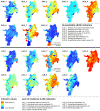Assessing socioeconomic vulnerability to dengue fever in Cali, Colombia: statistical vs expert-based modeling
- PMID: 23945265
- PMCID: PMC3765508
- DOI: 10.1186/1476-072X-12-36
Assessing socioeconomic vulnerability to dengue fever in Cali, Colombia: statistical vs expert-based modeling
Abstract
Background: As a result of changes in climatic conditions and greater resistance to insecticides, many regions across the globe, including Colombia, have been facing a resurgence of vector-borne diseases, and dengue fever in particular. Timely information on both (1) the spatial distribution of the disease, and (2) prevailing vulnerabilities of the population are needed to adequately plan targeted preventive intervention. We propose a methodology for the spatial assessment of current socioeconomic vulnerabilities to dengue fever in Cali, a tropical urban environment of Colombia.
Methods: Based on a set of socioeconomic and demographic indicators derived from census data and ancillary geospatial datasets, we develop a spatial approach for both expert-based and purely statistical-based modeling of current vulnerability levels across 340 neighborhoods of the city using a Geographic Information System (GIS). The results of both approaches are comparatively evaluated by means of spatial statistics. A web-based approach is proposed to facilitate the visualization and the dissemination of the output vulnerability index to the community.
Results: The statistical and the expert-based modeling approach exhibit a high concordance, globally, and spatially. The expert-based approach indicates a slightly higher vulnerability mean (0.53) and vulnerability median (0.56) across all neighborhoods, compared to the purely statistical approach (mean = 0.48; median = 0.49). Both approaches reveal that high values of vulnerability tend to cluster in the eastern, north-eastern, and western part of the city. These are poor neighborhoods with high percentages of young (i.e., < 15 years) and illiterate residents, as well as a high proportion of individuals being either unemployed or doing housework.
Conclusions: Both modeling approaches reveal similar outputs, indicating that in the absence of local expertise, statistical approaches could be used, with caution. By decomposing identified vulnerability "hotspots" into their underlying factors, our approach provides valuable information on both (1) the location of neighborhoods, and (2) vulnerability factors that should be given priority in the context of targeted intervention strategies. The results support decision makers to allocate resources in a manner that may reduce existing susceptibilities and strengthen resilience, and thus help to reduce the burden of vector-borne diseases.
Figures







Similar articles
-
Space-Time Conditional Autoregressive Modeling to Estimate Neighborhood-Level Risks for Dengue Fever in Cali, Colombia.Am J Trop Med Hyg. 2020 Nov;103(5):2040-2053. doi: 10.4269/ajtmh.20-0080. Am J Trop Med Hyg. 2020. PMID: 32876013 Free PMC article.
-
A WebGIS tool for visualizing and exploring socioeconomic vulnerability to dengue fever in Cali, Colombia.Geospat Health. 2013 Nov;8(1):313-6. doi: 10.4081/gh.2013.76. Geospat Health. 2013. PMID: 24258905
-
A spatial model of socioeconomic and environmental determinants of dengue fever in Cali, Colombia.Acta Trop. 2016 Dec;164:169-176. doi: 10.1016/j.actatropica.2016.08.028. Epub 2016 Sep 9. Acta Trop. 2016. PMID: 27619189
-
Use of mapping and spatial and space-time modeling approaches in operational control of Aedes aegypti and dengue.PLoS Negl Trop Dis. 2009;3(4):e411. doi: 10.1371/journal.pntd.0000411. Epub 2009 Apr 28. PLoS Negl Trop Dis. 2009. PMID: 19399163 Free PMC article. Review.
-
[Dengue, geoprocessing, and socioeconomic and environmental indicators: a review].Rev Panam Salud Publica. 2009 May;25(5):456-61. doi: 10.1590/s1020-49892009000500012. Rev Panam Salud Publica. 2009. PMID: 19695137 Review. Portuguese.
Cited by
-
Space-Time Conditional Autoregressive Modeling to Estimate Neighborhood-Level Risks for Dengue Fever in Cali, Colombia.Am J Trop Med Hyg. 2020 Nov;103(5):2040-2053. doi: 10.4269/ajtmh.20-0080. Am J Trop Med Hyg. 2020. PMID: 32876013 Free PMC article.
-
Predicting Aedes aegypti infestation using landscape and thermal features.Sci Rep. 2020 Dec 10;10(1):21688. doi: 10.1038/s41598-020-78755-8. Sci Rep. 2020. PMID: 33303912 Free PMC article.
-
Integrating vulnerability and hazard in malaria risk mapping: the elimination context of Senegal.BMC Infect Dis. 2025 Aug 18;25(1):1031. doi: 10.1186/s12879-025-11412-5. BMC Infect Dis. 2025. PMID: 40826047 Free PMC article.
-
Arbovirosis and potential transmission blocking vaccines.Parasit Vectors. 2016 Sep 23;9(1):516. doi: 10.1186/s13071-016-1802-0. Parasit Vectors. 2016. PMID: 27664127 Free PMC article. Review.
-
Quantitative assessment of a spatial multicriteria model for highly pathogenic avian influenza H5N1 in Thailand, and application in Cambodia.Sci Rep. 2016 Aug 4;6:31096. doi: 10.1038/srep31096. Sci Rep. 2016. PMID: 27489997 Free PMC article.
References
-
- Intergovernmental Panel on Climate Change. Climate change 2007: the physical science basis. contribution of working group I to the fourth assessment report of the intergovernmental panel on climate change. Cambridge, UK, and New York, NY, USA: Cambridge University Press; 2007.
-
- Gubler DJ. Epidemic dengue/dengue hemorrhagic fever as a public health, social and economic problem in the 21st century. Trends Microbiol. 2002;10:100–103. - PubMed
Publication types
MeSH terms
LinkOut - more resources
Full Text Sources
Other Literature Sources
Medical
Research Materials

